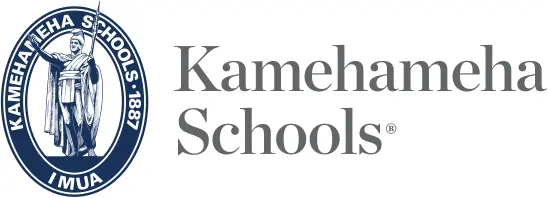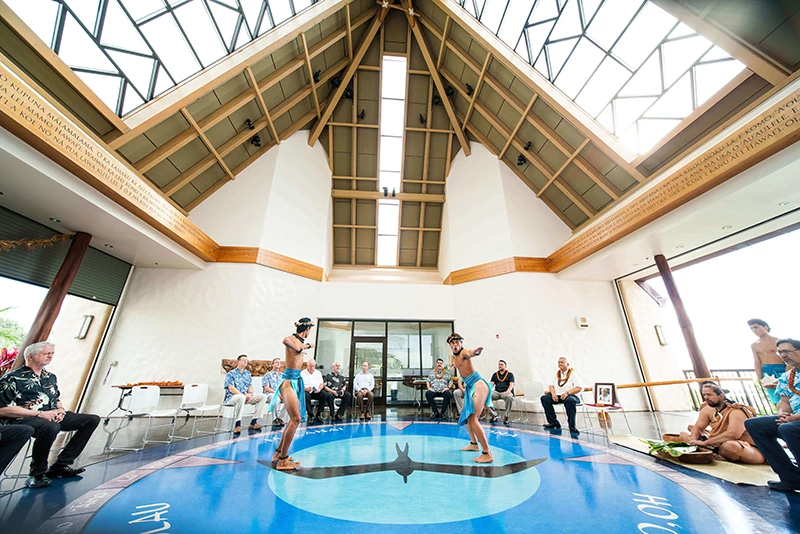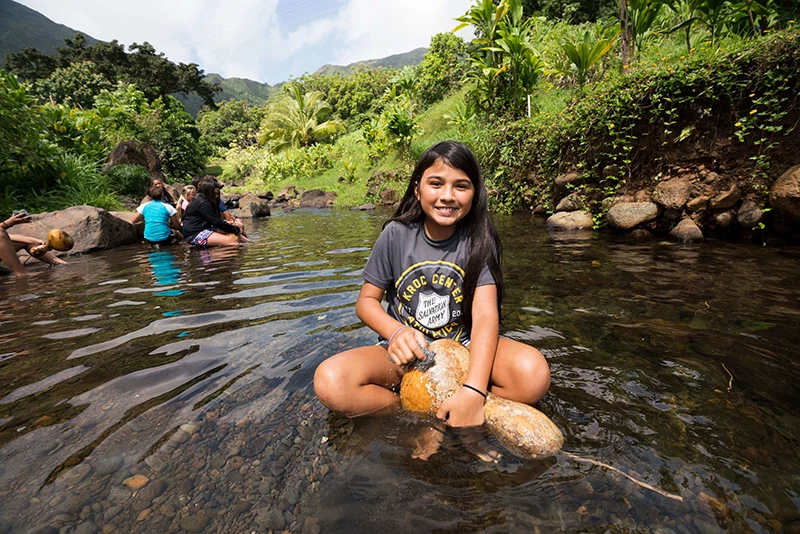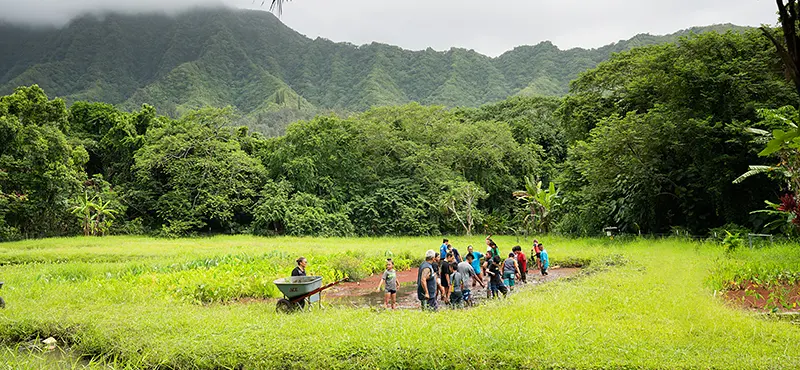Oct. 1, 2024

This mo‘olelo first appeared in I Mua magazine. Read the full issue.
Story
Justin Barfield and Crystal Kua KSK'81
Photos
Jacob Chinn
As a child growing up in Punalu‘u, Margaret Kau‘i Mattoon Weiss KSK’80 hiked the valley to pick ‘awapuhi buds and plumeria to make lei and gathered limu at the shoreline with her grandma.
“Punalu’u has been described as a ‘place of abundance’ — he ‘āina momona,” Weiss said.
Weiss now finds herself continuing to carry on the kuleana of her late parents, Creighton and Cathleen Oberle Mattoon KSK’50, both of whom were well-known community leaders who advocated around the efforts of mālama ‘āina.
“Punalu‘u translates as ‘diving spring,’ implying a spring of fresh water,” Weiss said. “My mother suggested that it was the cool spring water that you can feel oozing up through your toes at the shoreline.”
Like Weiss, the family of Racine Hee KSK’89 has been living in Punalu‘u for generations, and she has fond memories of fishing with her kupuna kāne.
“My grandfather was an avid fisherman who was known in the community for his fishing skills. He used topography in Punalu‘u to mark special fishing spots — knowledge which he passed down to my brother and that continues to be used by my family today,” said Hee. “Fishing has provided food for my family for several generations, as well as other families in the community.”
Auntie Kapua Ka‘apu Sproat Fonoimoana KSK’56 grew up in a hale pili built by her father, a home surrounded by kalo fed by the stream’s waters. She recounted how her father built an entire Hawaiian village — or kauhale — on their two-acre ‘ohana parcel that shares a boundary with Kamehameha Schools. They would practice traditional ways, including pounding their own poi, and her father was often seen in the community wearing his red malo. “We ate entirely off the land,” Fonoimoana said.
“Punalu‘u translates as ‘diving spring,’ implying a spring of fresh water. My mother suggested that it was the cool spring water that you can feel oozing up through your toes at the shoreline.”
Margaret Kauʻi Matoon Weiss KSK'80
Surrounded by coconut trees her father planted in the 1920s, their family kauhale was such a remarkable place that, according to news accounts, U.S. President Franklin Delano Roosevelt stopped by during a visit to Hawai‘i in the 1930s.
Fonoimoana remembers walking across Punalu‘u as a child to get to other places along the coast, including all the way to Sacred Falls.
“We worked the taro patches,” she said. “There was a lot of water running. This was our playground. We inhabited these mountains — we thought they were our mountains.”
As members of the Punalu‘u Community Association, these three leaders — and their predecessors, such as the Mattoons — spent years providing a community voice to Kamehameha Schools around the Punalu‘u Stream Restoration Project, which was designed and completed by Kamehameha Schools to use traditional ahupua‘a management strategies to provide flood control and restore natural ecology to the stream. Kamehameha Schools is a major landowner in Punalu‘u, owning approximately 3,600 acres or 60 percent of lands in Punalu‘u.
As alums, the three women also see that their kuleana goes deeper, not only as community members but as Native Hawaiians. “As an alum, it gave me a sense that you have to care for our resources where I live. I felt a connection to the project being an alumni,” said Hee, who is the president of the Punalu‘u Community Association.
Weiss and Fonoimoana were on hand to give remarks on behalf of the community during an event celebrating the completion of the Punalu‘u Stream Restoration project on Oct. 7, 2023.
“The community is optimistic about the future of agriculture in Punalu‘u and the continued preservation of the ‘āina that we come from,” Weiss told the crowd of about 100. “That is our collective kuleana and we look forward to this shared venture.”
“We worked the taro patches. There was a lot of water running. This was our playground. We inhabited these mountains — we thought they were our mountains.”
Kapua Ka‘apu Sproat Fonoimoana KSK’56
The goals of the Punalu‘u Stream Restoration Project were as follows:
• Restore stream and floodplain processes
• Mitigate flood impacts
• Protect cultural and natural resources
• Increase community engagement
• Conduct ‘āina-based learning
“Community safety is a prime focus of this project, and it is our hope that through stewardship of these lands, we can also improve agricultural sustainability, stimulate learning opportunities, and nurture a healthy and vibrant community while perpetuating its rural character,” said Jason Jeremiah KSK’00, Kamehameha Schools’ lead on this project.
Punalu‘u Stream is located on O‘ahu within the mokupuni of Ko‘olauloa and the ahupua‘a of Punalu‘u. In the 15th century, Kalamakua, the ruling chief of O‘ahu, is credited with establishing numerous ‘auwai (irrigation ditches) and agricultural terraces throughout the island. In Ko‘olauloa, the creation of these irrigation systems sustained a sizeable population for many generations.
In Punalu‘u, the earliest accounts of the area note that an extensive lo‘i kalo and ‘auwai system existed and that significant amounts of kalo were cultivated there. Kahana and Punalu‘u were known as the bread baskets of Ko‘olauloa.
The Punalu‘u ahupua‘a has been affected by a range of historical impacts, including water diversions; invasion by non-native aquatic, plant and animal life; stream channelization; unprotected stream crossings; land grading and alteration of natural drainage patterns; tillage; livestock grazing; aquaculture; and residential development.
Over 50 acres of the lower Punalu‘u Valley have flooded annually. Flooding caused economic hardship and appeared to worsen, possibly due to sedimentation within the stream. Flooding on July 19, 2014, damaged roads, properties, fields and crops.
KS identified the lower Punalu‘u Stream Valley as an opportunity to implement a project incorporating its ahupua‘a management strategy to provide flood mitigation and restore natural ecological form and process.
The project design restored the natural valley floodplain and terraces, relocated farmers from flood-prone lands to elevated terraces, and reconnected Punalu‘u Stream with its floodplain, enhancing the ecosystem’s health and resilience against chronic flooding.
Jesse Frey, Kamehameha Schools senior capital project manager, said this project is unprecedented.
“The beautiful part about this project was that there was no road map for this. No one had ever done a restoration project of this magnitude ever in Hawai‘i,” Frey said. “We’re not building a development here — we’re restoring the land, and that process was innovative.”
Jerry Morgan, a project manager with contractor Goodfellow Brothers, said that the area was packed with trees and brush when they started.
“When we first came to this site, we couldn’t really see anything. It was just all completely full of cane grass and we had all different kinds of plants, invasive plants, so we had to kind of make our way through all the grass and try to find where the stream was at,” Morgan said. “You’ve got peek-a-boo spots of the stream, but you never really got a full range of magnitude of what the site would look like.”
Cultural and environmental monitors were also on site to ensure the protection of sensitive areas. The work reduced the probability of flooding problems and soil erosion.
“Basically, we recreated the dynamics of the floodplain and made sure that if the stream does come up, it comes up in the floodplain and leaves the farmers’ fields so they won’t be moved or disturbed from their hard work,” Morgan said.
“We had to clear 100 acres of invasive species. When we first came on, you couldn’t see across the valley. Once we opened that up, we had community members say it was the first time they felt the breeze in generations,” Frey said.
The restoration project also included planting 50,000 native plants in the project area, and the work is already attracting native water birds and other species back to the area.
“It’s creating habitat for endangered birds, and we have nesting birds creating little babies that are cruising around,” said Matt Schirman, co-founder along with Rick Barboza KSK’93 of Hui Kū Maoli Ola. This contractor provided oversight of the plantings that helped to create a riparian ecosystem.
Fonoimoana recalls how the stream fed and sustained the limu ‘ele‘ele along the coastline and was integral to the ecosystem of the valley and the shoreline.
In 2007, KS initiated community consultation on the Punalu‘u Ahupua‘a Plan, which included stream stewardship and flood mitigation planning concepts. The plan was finalized in 2010. Since then, KS has sought to obtain various federal, state and city permits and approvals with the final approvals received in 2022.
Hee said that being part of the outreach throughout the construction process allowed the community to stay informed.
“It really did help to stop rumors,” she said. “The information was very straightforward.”
Hee said that she likes to think that kūpuna like the Mattoons, would be pleased with the work. “I think they would be very happy it was completed,” Hee said.









